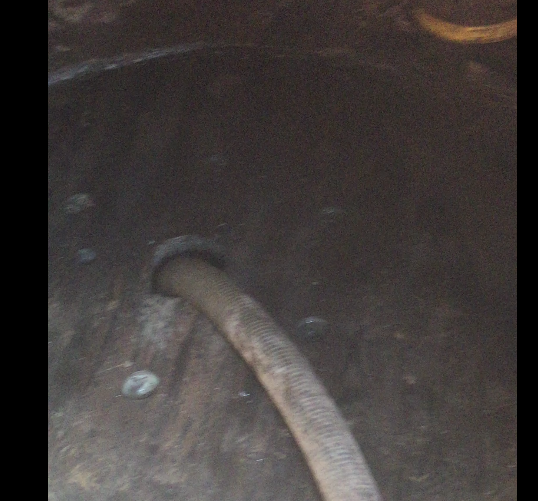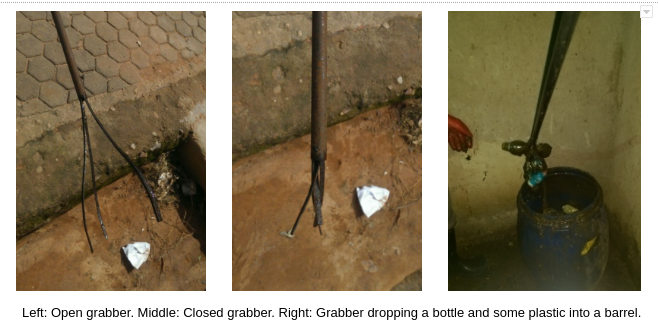- Forum
- categories
- Sanitation systems
- Faecal sludge management (FSM)
- Faecal sludge transport (including emptying of pits and septic tanks, transfer stations)
- Clearing trash from pit latrines-A new device
Clearing trash from pit latrines-A new device
8438 views
- rochelleholm
-
 Less
Less- Posts: 99
- Karma: 4
- Likes received: 38
Just a forum update that last week we wrapped up field testing of Dale's devices here in Mzuzu, Malawi, it is essential to test new devices on real pit latrines under real conditions. Both the successes and challenges we experienced will improve the final device designs. More updates on the field testing to be posted soon.
Rochelle Holm, Ph.D., PMP
Mzuzu (Malawi)
Mzuzu (Malawi)
The following user(s) like this post: Elisabeth
Please Log in to join the conversation.
You need to login to reply- dandreatta
-
 Topic Author
Topic Author- I am a mechanical engineer and work for a consulting company. I do projects around water, cookstoves, and sanitation in my spare time.
Less- Posts: 48
- Karma: 4
- Likes received: 17
Laura,
(We'll communicate offline about coming to Kigali.)
Thanks for the compliments. I forwarded them to my former students, who have now graduated and are starting their careers.
I'm generally familiar with "The Grabber". It appears to be similar to "The Claw" that was described in a paper by Holm, et. al. recently. Any of these devices should be able to be used without a long handle, by attaching a weight at the right location. Then the operation would be managed by two ropes, one for gripping and raising, and the other for opening the grip. The crabtrap could also be used with a weight. I started to work on a prototype grabber last night, and the weight arrangement seems to work well. I'll finish this work in a few days and post something more some time next week.
I imagine one could bend the screen of any of these devices to fit whatever squatting hole size was available. I'll also work on this feature.
Thanks,
Dale Andreatta
This email address is being protected from spambots. You need JavaScript enabled to view it.
(We'll communicate offline about coming to Kigali.)
Thanks for the compliments. I forwarded them to my former students, who have now graduated and are starting their careers.
I'm generally familiar with "The Grabber". It appears to be similar to "The Claw" that was described in a paper by Holm, et. al. recently. Any of these devices should be able to be used without a long handle, by attaching a weight at the right location. Then the operation would be managed by two ropes, one for gripping and raising, and the other for opening the grip. The crabtrap could also be used with a weight. I started to work on a prototype grabber last night, and the weight arrangement seems to work well. I'll finish this work in a few days and post something more some time next week.
I imagine one could bend the screen of any of these devices to fit whatever squatting hole size was available. I'll also work on this feature.
Thanks,
Dale Andreatta
This email address is being protected from spambots. You need JavaScript enabled to view it.
Dale Andreatta, Ph.D., P.E.
Mechanical Engineer
Mechanical Engineer
Please Log in to join the conversation.
You need to login to reply- mst
-

- Laura Stupin | Freelance Field Engineer | Kigali, Rwanda
Less- Posts: 3
- Likes received: 2
Tools for picking out trash from pit latrines are soooo important, thank you for working on this!!! I was very excited to see in your video that the trash tool does not have a pole. Our pit-emptying team in Kigali struggles with extending the poles on their trash tools. They often have to remove a metal roof panel in order to fish out trash because the pole needs to be so long. It's also quite tedious for them to extend the length of the pole with different screwing mechanisms we've tried.
You're also absolutely correct that typical trash-fishing hooks are not good at capturing bottles.
In Kigali, the drop hole sizes/shapes vary widely. For example, below is a picture of a completely circular hole that is roughly 5 inches in diameter. Is there any way to make the crab trap more flexible instead of rigid so that it's more likely to accommodate different types of holes?
Screen size is not a big deal. We can pump condoms no problem. It's really bottles, pads, large rags that cause us headaches.
It would be great to try your trash tool in Kigali. Would you or the students be interested in making a visit here or sending a prototype that one of our Pit Vidura teams could try?
Also, another idea you might want to try to iterate on or to remove the pole from is "the grabber" trash tool developed by the Excrevator team at NCSU. It is a claw that opens and closes by pushing/pulling the fingers through a tube. The Pit Vidura team in Kigali has found this tool very useful especially for pulling out bottles. It fits in any drophole, but it's limited to the length of the pole. Is it possible to adapt this design for something with string similar to the crab trap?
You asked: "Where is the trash in a pit latrine, is it floating on top of the thin liquid, or down deep in the thick sludge at the bottom?"
Both, but it's really the trash floating near the top that causes us problems and clogs up our pump. Clearing out trash floating at the top would be a huge help for us.
Please contact me if you're interesting in chatting about field trials in Kigali!
-L
You're also absolutely correct that typical trash-fishing hooks are not good at capturing bottles.
In Kigali, the drop hole sizes/shapes vary widely. For example, below is a picture of a completely circular hole that is roughly 5 inches in diameter. Is there any way to make the crab trap more flexible instead of rigid so that it's more likely to accommodate different types of holes?
Screen size is not a big deal. We can pump condoms no problem. It's really bottles, pads, large rags that cause us headaches.
It would be great to try your trash tool in Kigali. Would you or the students be interested in making a visit here or sending a prototype that one of our Pit Vidura teams could try?
Also, another idea you might want to try to iterate on or to remove the pole from is "the grabber" trash tool developed by the Excrevator team at NCSU. It is a claw that opens and closes by pushing/pulling the fingers through a tube. The Pit Vidura team in Kigali has found this tool very useful especially for pulling out bottles. It fits in any drophole, but it's limited to the length of the pole. Is it possible to adapt this design for something with string similar to the crab trap?
You asked: "Where is the trash in a pit latrine, is it floating on top of the thin liquid, or down deep in the thick sludge at the bottom?"
Both, but it's really the trash floating near the top that causes us problems and clogs up our pump. Clearing out trash floating at the top would be a huge help for us.
Please contact me if you're interesting in chatting about field trials in Kigali!
-L
Laura Stupin
Freelance Field Engineer
Kigali, Rwanda
Freelance Field Engineer
Kigali, Rwanda
Attachments:
-
 pithole.png
(Filesize: 372KB)
pithole.png
(Filesize: 372KB)
-
 NCSU-grabber.png
(Filesize: 247KB)
NCSU-grabber.png
(Filesize: 247KB)
Please Log in to join the conversation.
You need to login to reply- dandreatta
-
 Topic Author
Topic Author- I am a mechanical engineer and work for a consulting company. I do projects around water, cookstoves, and sanitation in my spare time.
Less- Posts: 48
- Karma: 4
- Likes received: 17
(Offline, Rochelle and I have worked out that I'm going to Malawi in September for field work. My first trip to Africa!)
In the paper, "Characteristics of pit latrines to support the design and selection of emptying tools in peri-urban Mzuzu, Malawi", in the Journal of Water, Sanitation and Hygiene, by Chiposa, Holm, et. al. it says of the 150 squatting holes measured the length ranged from 15 to 30 cm with an average of 23, and the width ranged from 10 to 22 cm with an average of 16.
I've defined a "minimum practical" hole with a length and width halfway between the minimum and the average, or 19 cm by 13 cm. I haven't done the statistical analysis, but I expect that if you fit bell-shaped statistical curves through this data you would find that 90% of the holes are larger than the minimum practical. I've been working on designing tools that fit through this size opening, and the students' crabtrap should fit easily. This appears to be a very small hole, and I expect that someone with a squatting hole smaller than this would not object to having their squatting hole enlarged a bit. Certainly there is no way even a small child could fall through this hole, if that is a concern.
The students actually designed their device for a 10 cm by 18 cm keyhole, much smaller than the minimum practical hole. One down side to the crabtrap is that it doesn't work in thicker sludge. Where is the trash in a pit latrine, is it floating on top of the thin liquid, or down deep in the thick sludge at the bottom?
Mostly, I'm working on bucket-based systems that pick up trash and sludge together. Currently I'm working on something similar to the Sludge Dipper, but with a smaller bucket that fits through the minimum practical hole. The full-size Sludge Dipper, as well as various other devices can be seen at:
In thicker sludge you can push the bucket of the Sludge Dipper down into the thick sludge with stick.
Dale Andreatta
In the paper, "Characteristics of pit latrines to support the design and selection of emptying tools in peri-urban Mzuzu, Malawi", in the Journal of Water, Sanitation and Hygiene, by Chiposa, Holm, et. al. it says of the 150 squatting holes measured the length ranged from 15 to 30 cm with an average of 23, and the width ranged from 10 to 22 cm with an average of 16.
I've defined a "minimum practical" hole with a length and width halfway between the minimum and the average, or 19 cm by 13 cm. I haven't done the statistical analysis, but I expect that if you fit bell-shaped statistical curves through this data you would find that 90% of the holes are larger than the minimum practical. I've been working on designing tools that fit through this size opening, and the students' crabtrap should fit easily. This appears to be a very small hole, and I expect that someone with a squatting hole smaller than this would not object to having their squatting hole enlarged a bit. Certainly there is no way even a small child could fall through this hole, if that is a concern.
The students actually designed their device for a 10 cm by 18 cm keyhole, much smaller than the minimum practical hole. One down side to the crabtrap is that it doesn't work in thicker sludge. Where is the trash in a pit latrine, is it floating on top of the thin liquid, or down deep in the thick sludge at the bottom?
Mostly, I'm working on bucket-based systems that pick up trash and sludge together. Currently I'm working on something similar to the Sludge Dipper, but with a smaller bucket that fits through the minimum practical hole. The full-size Sludge Dipper, as well as various other devices can be seen at:
In thicker sludge you can push the bucket of the Sludge Dipper down into the thick sludge with stick.
Dale Andreatta
Dale Andreatta, Ph.D., P.E.
Mechanical Engineer
Mechanical Engineer
The following user(s) like this post: Elisabeth
Please Log in to join the conversation.
You need to login to reply- stevensugden
-
 Less
Less- Posts: 32
- Karma: 8
- Likes received: 28
- rochelleholm
-
 Less
Less- Posts: 99
- Karma: 4
- Likes received: 38
Hi Dale,
Your pit latrine trash "grabber" is interesting, trash is a big problem for emptying in Malawi. I like that the device fits through the keyhole. One issue, at least in Malawi, is that keyholes are not standard in size or shape. Otherwise, I think you have an interesting and innovative tool design.
We would like to invite your team to consider field trials in Mzuzu, Malawi alongside some of our other FSM research. Please contact me if you are interested in this.
Your pit latrine trash "grabber" is interesting, trash is a big problem for emptying in Malawi. I like that the device fits through the keyhole. One issue, at least in Malawi, is that keyholes are not standard in size or shape. Otherwise, I think you have an interesting and innovative tool design.
We would like to invite your team to consider field trials in Mzuzu, Malawi alongside some of our other FSM research. Please contact me if you are interested in this.
Rochelle Holm, Ph.D., PMP
Mzuzu (Malawi)
Mzuzu (Malawi)
Please Log in to join the conversation.
You need to login to reply- dandreatta
-
 Topic Author
Topic Author- I am a mechanical engineer and work for a consulting company. I do projects around water, cookstoves, and sanitation in my spare time.
Less- Posts: 48
- Karma: 4
- Likes received: 17
Recently, I worked with an engineering student group at The Ohio State University in America. Their project was about getting the sludge (with lots of trash) out of a pit latrine while going through a small squatting hole. If you don't have to do anything with the slab, that's a bit advantage. And do this while working under a low ceiling, so no long poles are allowed.
Their solution was to use two devices, one for the trash and one for the more liquid contents. I don't think their liquid content device is ready to share yet, but I really like their trash pickup device. They call it "the crabtrap" because it looks like something you could also use for fishing for crabs, and I suppose you could with the right bait. A link to a youtube video is below, and I attach a few still photos to get people interested.
This device picks up bottles and similar objects, as well as just about any other kind of trash. I would have to think that the current "fishing" devices used to clear trash from pits work well on bags and rags but have great difficulty in picking up certain types of trash, such as bottles. Reportedly, such fishing devices are very dirty, particularly when getting the trash off the hooks.
The device you see here is a prototype, the final device would need to be more rugged and have some other small design changes. A finer screen might be an improvement to keep the condoms and small trash in the crabtrap. I told the students to assume the smallest possible squatting hole, a keyhole of 10 by 18 cm. Squatting holes that were even a little larger would allow a larger device which would be easier and faster than seen in the video. The size of the device could be set to match the smallest squatting hole locally. Some recent postings from Chiposa, Holm, et. al, suggest that squatting holes are usually much larger than seen here, at least in Malawi.
The video is at:
Thank you,
Dale Andreatta, Ph.D., P.E.
Mechanical Engineer
Adjunct Professor, The Ohio State University
Their solution was to use two devices, one for the trash and one for the more liquid contents. I don't think their liquid content device is ready to share yet, but I really like their trash pickup device. They call it "the crabtrap" because it looks like something you could also use for fishing for crabs, and I suppose you could with the right bait. A link to a youtube video is below, and I attach a few still photos to get people interested.
This device picks up bottles and similar objects, as well as just about any other kind of trash. I would have to think that the current "fishing" devices used to clear trash from pits work well on bags and rags but have great difficulty in picking up certain types of trash, such as bottles. Reportedly, such fishing devices are very dirty, particularly when getting the trash off the hooks.
The device you see here is a prototype, the final device would need to be more rugged and have some other small design changes. A finer screen might be an improvement to keep the condoms and small trash in the crabtrap. I told the students to assume the smallest possible squatting hole, a keyhole of 10 by 18 cm. Squatting holes that were even a little larger would allow a larger device which would be easier and faster than seen in the video. The size of the device could be set to match the smallest squatting hole locally. Some recent postings from Chiposa, Holm, et. al, suggest that squatting holes are usually much larger than seen here, at least in Malawi.
The video is at:
Thank you,
Dale Andreatta, Ph.D., P.E.
Mechanical Engineer
Adjunct Professor, The Ohio State University
Dale Andreatta, Ph.D., P.E.
Mechanical Engineer
Mechanical Engineer
Attachments:
-
SAM_1029.JPG (Filesize: 166KB)
-
SAM_1030.JPG (Filesize: 161KB)
-
SAM_1031.JPG (Filesize: 161KB)
The following user(s) like this post: mst
Please Log in to join the conversation.
You need to login to reply
Share this thread:
- Forum
- categories
- Sanitation systems
- Faecal sludge management (FSM)
- Faecal sludge transport (including emptying of pits and septic tanks, transfer stations)
- Clearing trash from pit latrines-A new device
Recently active users. Who else has been active?
Time to create page: 0.242 seconds







